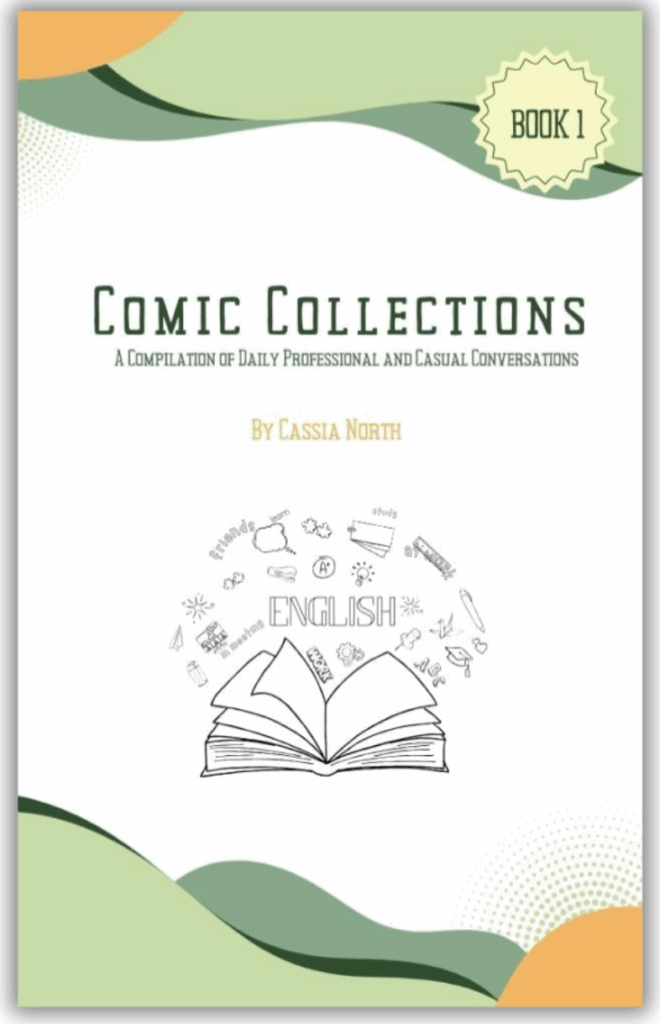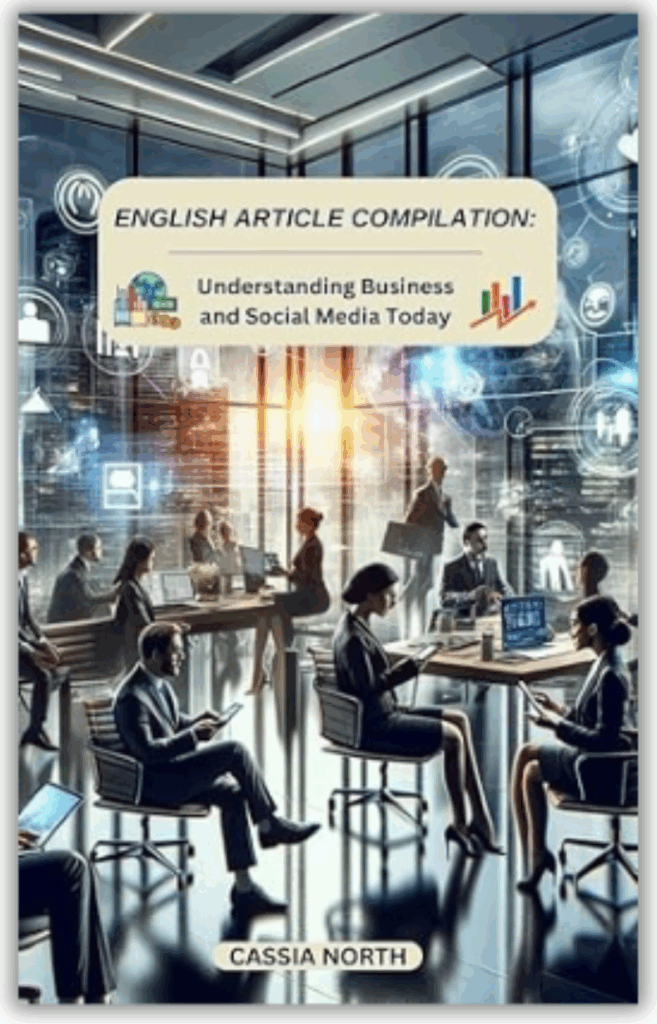
English Grammar for Business
"Let's Learn, Explore, and Connect to the World"

Clarity & Concision in Communication
- Jenelie Hijosa
- English Grammar for Business

Introduction

Strong and clear communication is essential for achieving accomplishments in business negotiations. Whether you’re closing a multi-million-dollar deal or resolving an internal conflict, the ability to convey your message clearly and concisely can make the difference between success and failure. In the fast-paced world of business, where decisions are often made quickly, and misunderstandings can lead to significant setbacks, mastering the art of communication is essential.
Clarity and concision are two critical components of effective communication. Clarity involves expressing your ideas in a straightforward and easy-to-understand manner, ensuring that your message is not lost in translation. On the other hand, concision means delivering your message succinctly, avoiding unnecessary details that could dilute the core of your message. Together, they form the bedrock of efficient and impactful communication, especially in high-stakes negotiations where every word counts.
This blog intends to highlight the importance of clarity and brevity in business negotiations. We will discuss the meanings and significance of these concepts, offer practical advice for enhancing communication skills, and identify common challenges along with strategies to overcome them. Furthermore, we will review real-life case studies that showcase the success of clear and concise communication in negotiations.
By the end of this blog, you will have a comprehensive understanding of how to enhance your communication skills to become a more effective negotiator. Whether you’re a seasoned professional or new to the field, these insights will equip you with the tools you need to navigate negotiations with confidence and precision.
Understanding Clarity in Business Communication
Definition of Clarity
Clarity in business communication means delivering messages in a straightforward, precise, and unambiguous manner. It involves using language that is easily understood by the audience, leaving no room for misinterpretation. In essence, clarity ensures that the intended message is accurately conveyed and comprehended, facilitating effective interaction and decision-making.
Importance of Clear Communication in Negotiations
Clear communication is paramount in business negotiations for several reasons:
1. Reduces Misunderstandings: Effective communication reduces the likelihood of misunderstandings that may result in conflicts, delays, or unsuccessful negotiations.
2. Builds Trust: When negotiators communicate clearly, it fosters trust and transparency, essential components for building strong business relationships.
3. Enhances Efficiency: Clear communication speeds up the negotiation process by ensuring that all parties are on the same page, making it easier to reach agreements.
4. Improves Outcomes: Negotiations are more likely to result in mutually beneficial outcomes when both parties clearly understand the terms and conditions being discussed.
Examples of Clear vs. Unclear Communication
Clear Communication Example:

“We propose a 10% discount on orders over 1,000 units, effective from August 1st.”
Unclear Communication Example:
“We might be able to offer some discounts on larger orders sometime in August.”
The clear example specifies the discount rate, the condition, and the effective date, leaving no room for ambiguity. In contrast, the unclear example is vague and open to multiple interpretations, potentially leading to confusion and prolonged negotiations.
Tips for Achieving Clarity

1. Use Simple Language: Steer clear of complex vocabulary and technical jargon that might be unfamiliar to everyone involved. Using simple, everyday language makes your message more accessible and easier to understand. For instance, instead of saying “utilize,” just say “use.”
2. Avoid Jargon: Business negotiations often involve participants from diverse backgrounds. Using industry-specific jargon can alienate those who are not familiar with the terminology. Always consider the audience and strive to use universally understood terms. For example, replace “synergy” with “working together.”
3. Be Specific and Concrete: Vague statements can lead to misinterpretations. Be specific and concrete in your communication to leave no room for doubt. For instance, instead of saying “soon,” provide a specific timeframe, like “by the end of this week.”
4. Active Voice over Passive Voice: The active voice makes sentences clearer and more direct, while the passive voice can make them sound vague and impersonal. Compare these two sentences:
- Active: “We will deliver the product by Friday.”
- Passive: “The product will be delivered by Friday.”
The active voice clearly identifies who is responsible for the action, enhancing the clarity of the message.
Implementing These Tips

Implementing these tips requires practice and a conscious effort to evaluate your communication style. Start by reviewing your emails, reports, and verbal communications for instances of complex language, jargon, vagueness, and passive constructions. Replace them with simpler words, clear terms, specific details, and active voice. Over time, these practices will become second nature, significantly enhancing the clarity of your business communication.
In the end, clarity is a crucial element of effective business communication, particularly in negotiations. By using simple language, avoiding jargon, being specific and concrete, and favoring the active voice, you can ensure that your messages are clear, reducing misunderstandings, building trust, and leading to more successful negotiation outcomes.
The Role of Concision in Business Negotiations
Definition of Concision

Concision in business communication refers to conveying information in a brief and direct manner without sacrificing clarity or essential details. It involves eliminating unnecessary words and focusing on the core message, ensuring that the communication is efficient and to the point. Concise communication helps in keeping the attention of the audience, making it easier to convey important information effectively.
Why Being Concise Matters in Negotiations
In business negotiations, time is often of the essence. Being concise helps in several ways:
1. Saves Time: Concise communication reduces the time spent on discussions, allowing negotiators to reach conclusions more quickly.
2. Maintains Attention: Long-winded explanations can lead to loss of focus. Concise communication keeps the audience engaged and attentive.
3. Enhances Persuasiveness: Clear and concise messages are more persuasive because they are easier to understand and remember.
4. Reduces Misunderstandings: By eliminating superfluous information, concise communication minimizes the risk of misinterpretation.
The Pitfalls of Over-Communication
Over-communication can dilute the core message and lead to confusion. It often results in:
1. Information Overload: Providing too much information can overwhelm the audience, making it difficult for them to identify the key points.
2. Loss of Focus: Excessive details can divert attention from the main issues, causing the discussion to veer off track.
3. Increased Misunderstandings: More words can create more opportunities for misinterpretation, leading to potential conflicts or delays.
Techniques for Concise Communication

Eliminate Redundancies
Redundant words and phrases add unnecessary length to your message without adding value. For instance, instead of saying “each and every,” simply say “each.” Review your communication for repetitive or superfluous words and remove them to streamline your message.

Focus on Key Points
Prioritize the most critical information and present it upfront. Determine the essential points that need to be communicated and ensure they are highlighted. This method ensures that your audience quickly understands the key points.

Use Bullet Points and Summaries
Using bullet points breaks down complex information into smaller, easier-to-understand pieces.
Summaries provide a quick overview of the main points, reinforcing the central message.
For example, instead of writing a lengthy paragraph, use bullet points to outline the key terms of a contract.

Practice Brevity in Writing and Speech
Get into the habit of being brief and to the point in both written and verbal communication. This practice involves reviewing and editing your messages to remove unnecessary words and focusing on delivering your point succinctly. For instance, in meetings, make your points clearly and avoid rambling.

Implementing Concise Communication
Achieving concision requires regular practice and self-awareness. Start by editing your emails, reports, and verbal pitches, aiming to reduce wordiness while maintaining the core message. With time, concise communication will become a natural part of your negotiation strategy, enhancing your effectiveness and efficiency.
In summary, concision is crucial in business negotiations because it saves time, maintains attention, enhances persuasiveness, and reduces misunderstandings. By eliminating redundancies, focusing on key points, using bullet points and summaries, and practicing brevity, you can ensure your communication is concise and impactful.
Strategies for Enhancing Clarity and Concision in Negotiations
Effective communication in business negotiations requires both clarity and concision. Here are comprehensive strategies to enhance these crucial aspects before, during, and after negotiations.
Preparing for the Negotiation

Know Your Objectives
Clearly establish your goals and desired outcomes before starting the negotiation. Understanding your objectives helps you stay focused and communicate your needs effectively. For instance, if you’re negotiating a contract, determine the key terms and conditions you must achieve.

Research and Anticipate Questions
Thorough preparation involves researching the other party’s interests, background, and potential questions they might ask. Anticipating these questions allows you to prepare clear, concise responses. For example, if you’re negotiating a pricing agreement, understand the market rates and the other party’s budget constraints.

Organize Your Thoughts and Materials
Arrange your thoughts and materials logically to ensure a smooth flow of information during the negotiation. Create an outline or checklist of the key points you want to cover. This organization helps you stay on track and communicate your message clearly. For example, have a list of bullet points summarizing your main arguments and data supporting your position.
During the Negotiation

Stay on Topic
Maintain focus on the issues at hand and avoid digressions. Staying on topic prevents confusion and ensures that all relevant points are addressed. If the conversation starts to drift, gently steer it back to the main issues. For example, if the discussion veers into unrelated topics, say, “Let’s circle back to our primary objective.”

Use Visual Aids and Summaries
Using visual aids like charts, graphs, and slides can help simplify complex information and make your points more memorable. Summarizing key points at regular intervals reinforces your message and ensures mutual understanding. For instance, use a graph to show cost savings over time or summarize the main terms of an agreement at the end of each discussion point.

Listen Actively and Confirm Understanding
Active listening means fully concentrating on the speaker, recognizing their points, and responding thoughtfully. Confirming understanding by paraphrasing their statements or asking clarifying questions ensures that both parties are on the same page. For example, say, “If I understand correctly, you are concerned about the delivery timeline. Is that right?”
Post-Negotiation Follow-Up

Summarize Agreements in Writing
After the negotiation, summarize the agreements in writing and share them with all parties involved. This written summary serves as a reference point and helps prevent misunderstandings. For example, send an email detailing the agreed-upon terms, timelines, and responsibilities.

Seek Feedback and Reflect on Communication Effectiveness
Request feedback from the other party and reflect on your communication effectiveness. Identifying what was successful and areas needing improvement can help you refine your negotiation skills. For instance, ask the other party if there were any points that were unclear or if they have suggestions for improving future communications.
Implementing These Strategies

Implementing these strategies requires a proactive and systematic approach. Before the negotiation, dedicate time to thoroughly prepare by defining objectives, researching, and organizing your materials. During the negotiation, stay focused, use visual aids, and practice active listening. After the negotiation, document the agreements and seek feedback for continuous improvement.
In summary, enhancing clarity and concision in business negotiations involves thorough preparation, focused communication during the negotiation, and effective follow-up. By knowing your objectives, anticipating questions, organizing your thoughts, staying on topic, using visual aids, listening actively, summarizing agreements, and seeking feedback, you can significantly improve your negotiation outcomes. These strategies not only facilitate clear and concise communication but also build trust and foster successful business relationships.
Common Challenges and How to Overcome Them
Business negotiations often present various challenges that can hinder effective communication.Tackling these challenges is essential for reaching successful outcomes. Here are some common obstacles and strategies to overcome them.
Dealing with Complex Information
Challenge: Negotiations frequently involve complex information, such as technical details, financial data, or legal terms. This complexity can lead to misunderstandings if not communicated clearly.
Strategy: Simplify complex information by breaking it down into manageable parts. Use visual aids like charts, graphs, and diagrams to illustrate key points. For example, instead of presenting raw data, use a graph to show trends or comparisons. Additionally, provide summaries and emphasize the most critical information to ensure your message is understood.
Handling Emotional Reactions
Challenge: Emotions can run high during negotiations, potentially leading to conflicts or irrational decisions. Emotional reactions can disrupt the flow of communication and obscure the core issues.
Strategy: Maintain a calm and professional demeanor. Practice active listening and acknowledge the other party’s emotions without letting them derail the negotiation. For example, if the other party becomes angry, calmly acknowledge their frustration and suggest taking a short break to cool down. It’s also helpful to focus on interests rather than positions, emphasizing common goals and seeking mutually beneficial solutions.
Navigating Cultural Differences
Challenge: Cultural differences can impact communication styles, expectations, and interpretations. Misunderstandings arising from these differences can hinder negotiation progress.
Strategy: Develop cultural awareness and sensitivity. Research the cultural backgrounds of the parties involved and adapt your communication style accordingly. For example, some cultures may value indirect communication and harmony, while others prefer direct and assertive approaches. Use respectful language, and be mindful of non-verbal cues, such as gestures and body language. If you’re uncertain, seek clarification to ensure comprehension.
Strategies for Overcoming These Challenges
Preparation and Clarity
Thorough preparation helps mitigate the impact of complex information and emotional reactions. Clearly define your objectives and anticipate potential challenges. Prepare concise summaries and visual aids to support your points.
Active Listening and Empathy
Active listening involves fully engaging with the speaker, showing empathy, and responding thoughtfully. This approach helps manage emotions and builds trust. For example, restate the other party’s concerns to show understanding and validate their feelings.
Flexibility and Adaptability
Stay flexible and modify your communication style to match the context and audience. This flexibility is vital when addressing cultural differences. Tailor your approach to meet the preferences and expectations of the other party.
Seek Common Ground
Focus on finding common ground and shared interests. Emphasizing mutual goals can help bridge gaps caused by complex information, emotional reactions, or cultural differences. For example, if both parties prioritize a long-term partnership, highlight this common objective to foster cooperation.
Use Mediators or Facilitators
In particularly challenging negotiations, consider involving a neutral mediator or facilitator. This third party can help manage emotions, clarify complex information, and bridge cultural gaps, ensuring a smoother negotiation process.
In summary, overcoming common challenges in business negotiations requires a combination of preparation, active listening, cultural awareness, and flexibility. By simplifying complex information, managing emotions, understanding cultural differences, and employing these strategies, you can enhance your communication effectiveness and achieve more successful negotiation outcomes.
Case Studies: Effective Clarity and Concision in Real Negotiations
Case Study 1: Successful Contract Negotiation

In a recent contract negotiation between a software development company and a major client, the project’s success hinged on clear and concise communication. The company needed to secure a long-term contract for a custom software solution.
Approach:
- Clarity: The software company provided a detailed proposal that clearly outlined the project’s scope, timeline, costs, and deliverables. Technical jargon was minimized, and each section was presented with specific and concrete details.
- Concision: During meetings, the company used bullet points and visual aids to highlight key aspects of the proposal, ensuring that the client could easily grasp the essential points. Redundant information was eliminated, focusing only on critical details.
Outcome:
The client appreciated the straightforward communication and felt confident in the company’s ability to deliver. The contract was signed with minimal revisions, and the project commenced smoothly.
Case Study 2: Resolving a Workplace Dispute

In a mid-sized manufacturing firm, a dispute arose between two departments over resource allocation. The prolonged disagreement was affecting productivity and morale.
Approach:
- Clarity: The HR department facilitated a meeting where each side presented their concerns and needs using clear, specific language. Avoiding vague complaints, they focused on concrete issues and desired outcomes.
- Concision: The mediator summarized the key points from both sides and used a whiteboard to visually map out the main issues and potential solutions. This approach helped keep the discussion on track and prevented it from becoming bogged down in unnecessary details.
Outcome:
The clarity and concision in communication led to a mutual understanding of each department’s needs. They reached a compromise on resource allocation that satisfied both parties, restoring harmony and improving overall efficiency.
Key Takeaways from Each Case Study
1. Importance of Preparation: Both cases demonstrate the value of thorough preparation. In the contract negotiation, a well-prepared proposal with clear details made the difference. In the workplace dispute, organizing thoughts and presenting them clearly helped resolve the issue.
2. Use of Visual Aids: Visual aids, such as bullet points, charts, and whiteboards, effectively highlighted key points and kept discussions focused and concise.
3. Focus on Key Points: Eliminating unnecessary information and focusing on the essential aspects of the negotiation facilitated faster and more successful outcomes.
4. Active Listening and Summarization: Summarizing key points during discussions ensured mutual understanding and kept negotiations on track.
In summary, these case studies illustrate how clarity and concision in communication can lead to successful negotiations by ensuring that all parties understand the issues and agree on solutions efficiently.
Tools and Resources for Improving Business Communication
Recommended Books and Articles
1. Books:
- “Crucial Conversations: Tools for Talking When Stakes Are High” by Kerry Patterson, Joseph Grenny, Ron McMillan, and Al Switzler – This book offers strategies for effective communication in high-pressure situations.
- “Made to Stick: Why Some Ideas Survive and Others Die” by Chip Heath and Dan Heath – A guide to making your ideas clear and memorable.
- “The Art of Negotiation: How to Improvise Agreement in a Chaotic World” by Michael Wheeler – Insights into the flexibility and clarity needed in negotiations.
2. Articles:
- Harvard Business Review’s articles on negotiation and communication, such as “The Necessary Art of Persuasion” and “How to Negotiate with a Liar”.
Online Courses and Workshops
1. Online Courses:
- Coursera: Courses like “Successful Negotiation: Essential Strategies and Skills” from the University of Michigan.
- edX: Courses such as “Negotiation and Leadership” from Harvard University.
- LinkedIn Learning: Courses like “Communicating with Confidence” and “Negotiation Skills”.
2. Workshops:
- Dale Carnegie Training: Workshops focusing on effective communication and negotiation skills.
- The Negotiation Institute: In-person and virtual workshops on negotiation tactics and strategies.
Communication Tools and Software
1. Tools:
- Grammarly: A tool for ensuring clear and error-free written communication.
- Hemingway Editor: Enhances your writing by highlighting complex sentences and common mistakes, making it bold and clear.
- MindMeister: A mind-mapping tool that helps organize thoughts and present them clearly.
2. Software:
- Slack: Facilitates clear and concise team communication through organized channels.
- Zoom: Enables effective virtual communication with features like screen sharing and recording for clarity.
By leveraging these resources, you can significantly enhance your business communication skills, leading to more successful negotiations and professional interactions.
Conclusion
 Effective communication is crucial for successful business negotiations. In this blog, we have discussed the significance of clarity and brevity in ensuring messages are understood and acted upon efficiently.
Effective communication is crucial for successful business negotiations. In this blog, we have discussed the significance of clarity and brevity in ensuring messages are understood and acted upon efficiently.
We began by defining clarity and concision, highlighting their significance in minimizing misunderstandings, building trust, and enhancing the overall efficiency of negotiations. Practical examples illustrated how clear and concise communication can streamline negotiations, and we provided actionable tips such as using simple language, avoiding jargon, focusing on key points, and employing active voice.
We then discussed strategies for enhancing clarity and concision, emphasizing the importance of preparation, staying on topic, using visual aids, and summarizing agreements.
Case studies demonstrated the real-world application of these principles, showing how clear and concise communication can lead to successful outcomes in contract negotiations and conflict resolution.
In overcoming common challenges like dealing with complex information, handling emotional reactions, and navigating cultural differences, we offered strategies that promote effective communication and understanding. Additionally, we highlighted various tools and resources, including books, online courses, and communication software, to further develop these essential skills.
The impact of clarity and concision on business success cannot be overstated. Clear and concise communication fosters stronger relationships, speeds up decision-making processes, and ensures that all parties are aligned with the objectives.
 We encourage you to apply the strategies discussed in this blog to enhance your negotiation skills and communication effectiveness. By practicing clarity and brevity, you will be better prepared to handle the complexities of business negotiations and achieve successful outcomes.
We encourage you to apply the strategies discussed in this blog to enhance your negotiation skills and communication effectiveness. By practicing clarity and brevity, you will be better prepared to handle the complexities of business negotiations and achieve successful outcomes.
Call to Action
Engage with this content by reflecting on your own communication practices and identifying areas for improvement. Subscribe to our blog for more tips and insights on effective business communication. Share your experiences and strategies for achieving clarity and concision in negotiations in the comments section. Your feedback and stories can inspire others to enhance their communication skills and succeed in their professional endeavors.
References
- Deescalation Training. (n.d.). NHS conflict resolution training – effective and engaging. https://www.deescalation.training/nhs-conflict-resolution-training/
- Examples.com. (n.d.). How to avoid miscommunication – 14+ examples, how to stop. https://www.examples.com/english/communication/miscommunication/how-to-avoid-miscommunication.html
- QuantHub. (n.d.). Calibrate visuals in a data storytelling message. https://www.quanthub.com/calibrate-visuals-in-a-data-storytelling-message/
- ICGG. (2023, March 29). The one trick to making your presentation slower, not slower. The 15th International Conference on Geometry and Graphics. https://www.icgg2012.org/2023/03/29/the-one-trick-to-making-your-presentation-slower-not-slower/
- Two Minute English. (n.d.). Is it correct to say “as per your request”? https://twominenglish.com/is-it-correct-to-say-as-per-your-request/
- Sebenius, J. K. (2013). The art of negotiation: How to improvise agreement in a chaotic world. Harvard Business School. https://www.hbs.edu/faculty/Pages/item.aspx?num=44376
Latest Blogs

Instagram Insights and Analytics: Understanding Your Audience and Measuring Campaign Success
Digital Marketing Blogs “Let’s Learn, Explore, and Connect to the World” Instagram Insights and Analytics: Understanding Your Audience and Measuring Introduction However, navigating this

Future (Be going to) 3
English Blogs “Let’s Learn, Explore, and Connect to the World” Future (Be going to) 3 III. Uses of ‘Be Going To’ The ‘be going to’
Reading comprehension quiz
Check out our books and more!

Comic Collections : A Compilation of Daily Professional and Casual Conversations (Book 1)
Laugh and learn with ‘Comic Collections’ by Cassia North – a delightful dive into everyday conversations in professional and casual settings, now in a vibrant, humor-filled ebook. Perfect for all ages!
Check out our Blogs!
Read our everyday blogs and gain new knowledge, skills, and inspiration to support your learning journey here in SEKAEL.


Explore English Blogs to improve your speaking, listening, reading, and writing skills in real-life situations.





 In the fast-paced world of business, effective communication is key to success. Visual aids, such as presentations, infographics, and charts, play a valuable role in conveying complicated information succinctly and clearly. They not only enhance understanding but also engage the audience, making your message more memorable. However, the impact of these visual aids can be significantly diminished by poor grammar. Errors in grammar can distract the audience, undermine credibility, and obscure the intended message.
In the fast-paced world of business, effective communication is key to success. Visual aids, such as presentations, infographics, and charts, play a valuable role in conveying complicated information succinctly and clearly. They not only enhance understanding but also engage the audience, making your message more memorable. However, the impact of these visual aids can be significantly diminished by poor grammar. Errors in grammar can distract the audience, undermine credibility, and obscure the intended message. This blog will go through the important aspects of grammar in visual aids for business communication. We will discuss common grammar mistakes, key grammar rules, and practical tips for structuring text in various types of visual aids. Additionally, we will highlight tools and resources that can help you perfect your grammar and provide real-world examples to describe the importance of these principles. Let’s dive into the world of grammar for effective visual aids and elevate your business communication to the next level.
This blog will go through the important aspects of grammar in visual aids for business communication. We will discuss common grammar mistakes, key grammar rules, and practical tips for structuring text in various types of visual aids. Additionally, we will highlight tools and resources that can help you perfect your grammar and provide real-world examples to describe the importance of these principles. Let’s dive into the world of grammar for effective visual aids and elevate your business communication to the next level.
 In business presentations, the use of jargon can be a double-edged sword. While it can streamline communication among industry insiders, it often poses significant barriers to understanding for broader audiences. This section explores what jargon is and the negative impacts it can have on your presentations.
In business presentations, the use of jargon can be a double-edged sword. While it can streamline communication among industry insiders, it often poses significant barriers to understanding for broader audiences. This section explores what jargon is and the negative impacts it can have on your presentations. Avoiding jargon is essential for making your business presentations clear and accessible. Here are three practical techniques to help you identify and replace jargon, use analogies and examples, and seek feedback to ensure your language is inclusive and comprehensible.
Avoiding jargon is essential for making your business presentations clear and accessible. Here are three practical techniques to help you identify and replace jargon, use analogies and examples, and seek feedback to ensure your language is inclusive and comprehensible. Punctuation marks are essential for clarifying the meaning of sentences and ensuring that your visual aids are easily readable. Misplaced or missing punctuation can alter the intended meaning and confuse the audience.
Punctuation marks are essential for clarifying the meaning of sentences and ensuring that your visual aids are easily readable. Misplaced or missing punctuation can alter the intended meaning and confuse the audience. Maintaining consistent tense and tone throughout your visual aids is vital for clarity and coherence. Shifts in tense and tone can confuse the audience and disrupt the flow of information.
Maintaining consistent tense and tone throughout your visual aids is vital for clarity and coherence. Shifts in tense and tone can confuse the audience and disrupt the flow of information. When we say parallelism, it involves using the same grammatical structure for similar elements within a list or series. This technique enhances readability and ensures that your visual aids are logically organized.
When we say parallelism, it involves using the same grammatical structure for similar elements within a list or series. This technique enhances readability and ensures that your visual aids are logically organized.


 Bullet points and numbering are powerful tools for breaking down complex information into digestible pieces. They enhance clarity and make it easier for the audience to follow your points.
Bullet points and numbering are powerful tools for breaking down complex information into digestible pieces. They enhance clarity and make it easier for the audience to follow your points.


















 In summary, effective visual aids rely on correct grammar to enhance clarity, professionalism, and engagement. Key points include maintaining subject-verb agreement, proper punctuation, consistent tense and tone, and parallelism. Additionally, structuring text with clear headings, white space, and bullet points, while avoiding common pitfalls, is crucial. Utilizing grammar tools, style guides, and training resources can further improve your presentations. By prioritizing grammar, you can elevate your business communication, ensuring your visual aids are impactful and professional. Implement these practices to achieve clearer, more effective, and credible business presentations.
In summary, effective visual aids rely on correct grammar to enhance clarity, professionalism, and engagement. Key points include maintaining subject-verb agreement, proper punctuation, consistent tense and tone, and parallelism. Additionally, structuring text with clear headings, white space, and bullet points, while avoiding common pitfalls, is crucial. Utilizing grammar tools, style guides, and training resources can further improve your presentations. By prioritizing grammar, you can elevate your business communication, ensuring your visual aids are impactful and professional. Implement these practices to achieve clearer, more effective, and credible business presentations.







 When giving a business presentation, how you communicate is essential for getting your ideas across well. Whether you are pitching a new idea, presenting quarterly results, or leading a team meeting, the words you choose can significantly influence your audience’s understanding and engagement. One common pitfall that presenters often encounter is the use of jargon – specialized terms that, while familiar within a particular industry, can alienate or confuse a broader audience.
When giving a business presentation, how you communicate is essential for getting your ideas across well. Whether you are pitching a new idea, presenting quarterly results, or leading a team meeting, the words you choose can significantly influence your audience’s understanding and engagement. One common pitfall that presenters often encounter is the use of jargon – specialized terms that, while familiar within a particular industry, can alienate or confuse a broader audience. In this topic, we will dig deeper into how important word choice is in business presentations, delve into the impact of jargon, and provide practical strategies for selecting the right words and avoiding jargon. By mastering these elements, you can elevate your presentations and communicate your ideas more effectively, ensuring your message resonates with any audience.
In this topic, we will dig deeper into how important word choice is in business presentations, delve into the impact of jargon, and provide practical strategies for selecting the right words and avoiding jargon. By mastering these elements, you can elevate your presentations and communicate your ideas more effectively, ensuring your message resonates with any audience.























 In the world of business, effective communication is the cornerstone of success. Whether it’s persuading potential investors, engaging colleagues during a meeting, or delivering a pitch to potential clients, the clarity of your message can significantly impact your professional image and outcomes. One crucial aspect of ensuring clear communication is the mastery of grammar, specifically subject-verb agreement and tense consistency.
In the world of business, effective communication is the cornerstone of success. Whether it’s persuading potential investors, engaging colleagues during a meeting, or delivering a pitch to potential clients, the clarity of your message can significantly impact your professional image and outcomes. One crucial aspect of ensuring clear communication is the mastery of grammar, specifically subject-verb agreement and tense consistency. Tense consistency refers to maintaining the same grammatical tense throughout a piece of writing or speech. When presenting, it’s vital to keep your tenses consistent, as shifting tenses can confuse the audience about when actions are happening. It ensures the timeline remains clear and logical, reinforcing the professionalism of the communication.
Tense consistency refers to maintaining the same grammatical tense throughout a piece of writing or speech. When presenting, it’s vital to keep your tenses consistent, as shifting tenses can confuse the audience about when actions are happening. It ensures the timeline remains clear and logical, reinforcing the professionalism of the communication. Subject-verb agreement is one of the key components of English grammar, ensuring that the verb in a sentence matches its subject in both number and person. This alignment is crucial for the clarity and correctness of any communication, especially in business environments where precision in language reflects professionalism and competence.
Subject-verb agreement is one of the key components of English grammar, ensuring that the verb in a sentence matches its subject in both number and person. This alignment is crucial for the clarity and correctness of any communication, especially in business environments where precision in language reflects professionalism and competence.


 In business presentations, the effective use of tenses not only clarifies the timeline of events but also helps in setting the tone and engaging the audience. Mastery over tense usage is integral to delivering clear and professional presentations that leave a lasting impression.
In business presentations, the effective use of tenses not only clarifies the timeline of events but also helps in setting the tone and engaging the audience. Mastery over tense usage is integral to delivering clear and professional presentations that leave a lasting impression.






 Create a list of sentences that include errors in subject-verb agreement and tense usage. Practice rewriting them correctly. This can be done as part of a daily writing exercise or incorporated into team training sessions.
Create a list of sentences that include errors in subject-verb agreement and tense usage. Practice rewriting them correctly. This can be done as part of a daily writing exercise or incorporated into team training sessions. Organize regular peer review sessions where team members present short talks or written content. Peers can provide feedback specifically on grammar and tense usage, helping each other identify and correct common mistakes.
Organize regular peer review sessions where team members present short talks or written content. Peers can provide feedback specifically on grammar and tense usage, helping each other identify and correct common mistakes. Employ grammar checking tools as part of the drafting process for presentations and documents. These tools can catch inconsistencies and errors that may be overlooked during manual editing.
Employ grammar checking tools as part of the drafting process for presentations and documents. These tools can catch inconsistencies and errors that may be overlooked during manual editing. Conduct role-playing exercises where participants prepare and deliver brief presentations. Focus the feedback on how well they integrate subject-verb agreement and tense consistency, providing concrete examples and corrections.
Conduct role-playing exercises where participants prepare and deliver brief presentations. Focus the feedback on how well they integrate subject-verb agreement and tense consistency, providing concrete examples and corrections.







 Throughout this blog, we have talked about the essential grammatical principles of subject-verb agreement and tense consistency, underlining their significance in the context of business presentations. By understanding and correctly applying these rules, professionals can communicate their ideas more clearly and effectively, enhancing the overall impact of their presentations.
Throughout this blog, we have talked about the essential grammatical principles of subject-verb agreement and tense consistency, underlining their significance in the context of business presentations. By understanding and correctly applying these rules, professionals can communicate their ideas more clearly and effectively, enhancing the overall impact of their presentations. The discussion on tense consistency highlighted how the careful selection of tenses can provide clarity about the timeline of events discussed during presentations. We reviewed how to choose the appropriate tense to reflect past, present, or future activities, reinforcing the narrative’s coherence. Real-life examples illustrated the impact of these grammatical elements on the professionalism and clarity of business communications.
The discussion on tense consistency highlighted how the careful selection of tenses can provide clarity about the timeline of events discussed during presentations. We reviewed how to choose the appropriate tense to reflect past, present, or future activities, reinforcing the narrative’s coherence. Real-life examples illustrated the impact of these grammatical elements on the professionalism and clarity of business communications. Moreover, we delved into advanced tools and techniques for enhancing grammatical skills, from online resources like Grammarly and the Purdue OWL to daily practices such as reading high-quality literature and engaging in regular writing exercises. These tools not only aid in correcting errors but also in understanding the underlying rules, which is crucial for long-term improvement.
Moreover, we delved into advanced tools and techniques for enhancing grammatical skills, from online resources like Grammarly and the Purdue OWL to daily practices such as reading high-quality literature and engaging in regular writing exercises. These tools not only aid in correcting errors but also in understanding the underlying rules, which is crucial for long-term improvement.




 In the world of business, the ability to communicate clearly and effectively is paramount. This is especially true when it comes to delivering business presentations, where the clarity of your message can significantly influence your professional credibility and the level of engagement of your audience. The mechanics and punctuation of your writing play a crucial role in conveying your ideas with precision and ensuring that your message is not only delivered but also received with the intended understanding.
In the world of business, the ability to communicate clearly and effectively is paramount. This is especially true when it comes to delivering business presentations, where the clarity of your message can significantly influence your professional credibility and the level of engagement of your audience. The mechanics and punctuation of your writing play a crucial role in conveying your ideas with precision and ensuring that your message is not only delivered but also received with the intended understanding. First, we will discuss the fundamentals of writing mechanics, including why they are important and how neglecting them can lead to misunderstandings or diminish the impact of your presentations. Next, we will delve into the nuances of punctuation, providing you with specific examples of how each punctuation mark should be used to enhance clarity and reader engagement. Additionally, we will discuss the intertwined roles of grammar and mechanics in creating compelling business content.
First, we will discuss the fundamentals of writing mechanics, including why they are important and how neglecting them can lead to misunderstandings or diminish the impact of your presentations. Next, we will delve into the nuances of punctuation, providing you with specific examples of how each punctuation mark should be used to enhance clarity and reader engagement. Additionally, we will discuss the intertwined roles of grammar and mechanics in creating compelling business content. In any form of business communication, the mechanics of writing—encompassing spelling, capitalization, punctuation, and typography—serve as the foundation for clear and effective expression. Understanding and applying these mechanics correctly is not merely a matter of linguistic correctness but a critical element in ensuring that the intended message is conveyed accurately and professionally.
In any form of business communication, the mechanics of writing—encompassing spelling, capitalization, punctuation, and typography—serve as the foundation for clear and effective expression. Understanding and applying these mechanics correctly is not merely a matter of linguistic correctness but a critical element in ensuring that the intended message is conveyed accurately and professionally. Writing mechanics refer to the rules and conventions that govern how we construct sentences and paragraphs in written language. This includes everything from the correct use of capitals and punctuation to the spelling of words and the spacing between sentences. In the context of business presentations, these mechanics are indispensable because they help maintain the structure and integrity of the information being presented. Proper use of mechanics enhances the readability of content and aids in the delivery of a clear, precise message. It also reflects the presenter’s attention to detail and respect for the audience, which can significantly influence the audience’s perception and reception of the content.
Writing mechanics refer to the rules and conventions that govern how we construct sentences and paragraphs in written language. This includes everything from the correct use of capitals and punctuation to the spelling of words and the spacing between sentences. In the context of business presentations, these mechanics are indispensable because they help maintain the structure and integrity of the information being presented. Proper use of mechanics enhances the readability of content and aids in the delivery of a clear, precise message. It also reflects the presenter’s attention to detail and respect for the audience, which can significantly influence the audience’s perception and reception of the content. One prevalent mechanical error in business writing is the misuse of capitalization, such as overcapitalizing job titles and general terms, which can distract readers and make them appear unprofessional. Punctuation errors, including misplaced commas and incorrect use of semicolons, can alter the meaning of sentences and lead to confusion.
One prevalent mechanical error in business writing is the misuse of capitalization, such as overcapitalizing job titles and general terms, which can distract readers and make them appear unprofessional. Punctuation errors, including misplaced commas and incorrect use of semicolons, can alter the meaning of sentences and lead to confusion.  Misplaced or missing apostrophes in contractions and possessives are another common issue that can reduce the credibility of the presentation. Furthermore, inconsistencies in typography—such as varying fonts, inappropriate use of bold or italics, and inconsistent headline casing—can disrupt the visual flow and professional appearance of business documents.
Misplaced or missing apostrophes in contractions and possessives are another common issue that can reduce the credibility of the presentation. Furthermore, inconsistencies in typography—such as varying fonts, inappropriate use of bold or italics, and inconsistent headline casing—can disrupt the visual flow and professional appearance of business documents. The mechanics of writing directly impact the readability of a presentation. For instance, correct punctuation can improve sentence flow and make the text easier to follow, thereby enhancing audience comprehension. Effective use of mechanics also ensures that each point is clearly defined and stands out, which is essential in maintaining the audience’s focus and interest throughout the presentation.
The mechanics of writing directly impact the readability of a presentation. For instance, correct punctuation can improve sentence flow and make the text easier to follow, thereby enhancing audience comprehension. Effective use of mechanics also ensures that each point is clearly defined and stands out, which is essential in maintaining the audience’s focus and interest throughout the presentation. Punctuation is an indispensable tool in business writing, serving not just to comply with grammatical rules but to enhance the clarity and impact of your presentations. Correct punctuation ensures that your message is not only understood but also received in the manner you intended. This section covers essential punctuation marks—the period, comma, semicolon, colon, and question mark—and provides specific examples and tips to help you utilize them effectively in your business communications.
Punctuation is an indispensable tool in business writing, serving not just to comply with grammatical rules but to enhance the clarity and impact of your presentations. Correct punctuation ensures that your message is not only understood but also received in the manner you intended. This section covers essential punctuation marks—the period, comma, semicolon, colon, and question mark—and provides specific examples and tips to help you utilize them effectively in your business communications. By mastering these punctuation marks, you can significantly enhance the clarity and professionalism of your business presentations. Understanding how to use punctuation effectively helps you communicate your message with precision and engage your audience more effectively. In the next section, we will explore the role of grammar in business presentations, further building on the foundation of effective communication skills.
By mastering these punctuation marks, you can significantly enhance the clarity and professionalism of your business presentations. Understanding how to use punctuation effectively helps you communicate your message with precision and engage your audience more effectively. In the next section, we will explore the role of grammar in business presentations, further building on the foundation of effective communication skills.







 Throughout this discussion on “Mechanics & Punctuation for Clarity,” we have explored the critical importance of mastering writing mechanics, punctuation, and grammar in crafting effective business presentations. The ability to communicate with precision and professionalism is indispensable in the business world, where every presentation can influence decisions, shape perceptions, and drive corporate strategies. Clear writing with proper mechanics and punctuation makes your message understandable and shows you care about your audience.
Throughout this discussion on “Mechanics & Punctuation for Clarity,” we have explored the critical importance of mastering writing mechanics, punctuation, and grammar in crafting effective business presentations. The ability to communicate with precision and professionalism is indispensable in the business world, where every presentation can influence decisions, shape perceptions, and drive corporate strategies. Clear writing with proper mechanics and punctuation makes your message understandable and shows you care about your audience. However, mastering these elements of language is not a one-time effort but a continuous journey. Ongoing learning and regular practice are keys to maintaining and enhancing your skills. Engage with current best practices, utilize tools and resources designed to aid in writing and proofreading, and seek feedback on your presentations to refine your approach.
However, mastering these elements of language is not a one-time effort but a continuous journey. Ongoing learning and regular practice are keys to maintaining and enhancing your skills. Engage with current best practices, utilize tools and resources designed to aid in writing and proofreading, and seek feedback on your presentations to refine your approach.
 By committing to these practices, you can ensure that your business communications are not only error-free but also impactful and effective. Elevate your professional presentations from good to exceptional, and watch as clearer communication opens doors to new opportunities and successes in your career.
By committing to these practices, you can ensure that your business communications are not only error-free but also impactful and effective. Elevate your professional presentations from good to exceptional, and watch as clearer communication opens doors to new opportunities and successes in your career.



 Clear communication is essential in business. Getting your point across in a simple and direct way can drastically improve your presentations. How well you explain your ideas can be the difference between a winning proposal and a forgettable one. Effective sentence structure is at the heart of this clarity. It ensures that your audience not only understands your points but also retains them, facilitating informed decisions and inspired action.
Clear communication is essential in business. Getting your point across in a simple and direct way can drastically improve your presentations. How well you explain your ideas can be the difference between a winning proposal and a forgettable one. Effective sentence structure is at the heart of this clarity. It ensures that your audience not only understands your points but also retains them, facilitating informed decisions and inspired action. This blog aims to demystify the elements of effective sentence structure in the context of Business English. We will begin by defining key components of sentence construction and exploring the types of sentences you can use to articulate your ideas. Following this, we’ll discuss the principles of crafting clear and impactful sentences, including tips on how to use the active voice and proper punctuation to your advantage.
This blog aims to demystify the elements of effective sentence structure in the context of Business English. We will begin by defining key components of sentence construction and exploring the types of sentences you can use to articulate your ideas. Following this, we’ll discuss the principles of crafting clear and impactful sentences, including tips on how to use the active voice and proper punctuation to your advantage.
 In business presentations, the clarity of your message can be greatly enhanced by using short, direct sentences. This approach helps to keep your audience focused and makes your key points stand out. Long, convoluted sentences can confuse listeners and dilute the impact of your message. By breaking complex ideas into simpler, standalone statements, you can make your content more digestible and retention-friendly.
In business presentations, the clarity of your message can be greatly enhanced by using short, direct sentences. This approach helps to keep your audience focused and makes your key points stand out. Long, convoluted sentences can confuse listeners and dilute the impact of your message. By breaking complex ideas into simpler, standalone statements, you can make your content more digestible and retention-friendly.










 In today’s digital-first business environment, emails have become the lifeline of professional communication, connecting colleagues, clients, and partners across the globe. In today’s professional world, writing strong business emails is no longer optional, it’s essential. Well-written emails ensure clear communication, foster professional relationships, and facilitate efficient business operations. Over previous discussions, we’ve laid a solid foundation by exploring key aspects of business email writing, including sentence structure & clarity, mechanics & punctuation, subject-verb agreement & tenses, and word choice & usage. These elements are essential for ensuring their recipients understand and take your emails seriously.
In today’s digital-first business environment, emails have become the lifeline of professional communication, connecting colleagues, clients, and partners across the globe. In today’s professional world, writing strong business emails is no longer optional, it’s essential. Well-written emails ensure clear communication, foster professional relationships, and facilitate efficient business operations. Over previous discussions, we’ve laid a solid foundation by exploring key aspects of business email writing, including sentence structure & clarity, mechanics & punctuation, subject-verb agreement & tenses, and word choice & usage. These elements are essential for ensuring their recipients understand and take your emails seriously. However, mastering business emails goes beyond these fundamental components. It requires understanding more nuanced aspects of communication, such as the email’s tone, structure, and etiquette surrounding email interactions. These additional tips focus on advanced strategies and etiquette that can significantly enhance the effectiveness of your email communication. From crafting concise and compelling messages to understanding the importance of cultural sensitivity, these strategies are designed to refine your email writing skills further.
However, mastering business emails goes beyond these fundamental components. It requires understanding more nuanced aspects of communication, such as the email’s tone, structure, and etiquette surrounding email interactions. These additional tips focus on advanced strategies and etiquette that can significantly enhance the effectiveness of your email communication. From crafting concise and compelling messages to understanding the importance of cultural sensitivity, these strategies are designed to refine your email writing skills further. In the realm of business emails, the ability to communicate with precision and brevity is invaluable. This approach not only respects the recipient’s time but also ensures your message is understood with minimal effort. It can be challenging to write emails that are both short and clear, but that’s the key to getting your message across effectively.
In the realm of business emails, the ability to communicate with precision and brevity is invaluable. This approach not only respects the recipient’s time but also ensures your message is understood with minimal effort. It can be challenging to write emails that are both short and clear, but that’s the key to getting your message across effectively. Conciseness in email communication is about delivering your message in the fewest possible words without omitting essential information. This efficiency allows the recipient to quickly grasp your message’s essence, enhancing the likelihood of a prompt and appropriate response. However, brevity should not come at the expense of clarity. Every sentence should serve a purpose, whether it’s to convey a key point, provide necessary details, or prompt action. The goal is to eliminate unnecessary words while ensuring your message remains clear and your intent unambiguous.
Conciseness in email communication is about delivering your message in the fewest possible words without omitting essential information. This efficiency allows the recipient to quickly grasp your message’s essence, enhancing the likelihood of a prompt and appropriate response. However, brevity should not come at the expense of clarity. Every sentence should serve a purpose, whether it’s to convey a key point, provide necessary details, or prompt action. The goal is to eliminate unnecessary words while ensuring your message remains clear and your intent unambiguous. Eliminating redundancy and fluff is crucial for writing concise emails. Redundancy occurs when the same information is repeated unnecessarily, while fluff consists of words, phrases, or sentences that do not add value to the message. To combat these issues, start by scrutinizing each sentence for unnecessary repetitions and superfluous information. Phrases like “I am writing to inform you” can often be removed, as the act of sending the email already implies this. Active voice gets straight to the point and uses fewer words, making your writing clear and easy to read. For instance, “The meeting was scheduled by the team” can be more succinctly expressed as “The team scheduled the meeting.”
Eliminating redundancy and fluff is crucial for writing concise emails. Redundancy occurs when the same information is repeated unnecessarily, while fluff consists of words, phrases, or sentences that do not add value to the message. To combat these issues, start by scrutinizing each sentence for unnecessary repetitions and superfluous information. Phrases like “I am writing to inform you” can often be removed, as the act of sending the email already implies this. Active voice gets straight to the point and uses fewer words, making your writing clear and easy to read. For instance, “The meeting was scheduled by the team” can be more succinctly expressed as “The team scheduled the meeting.” The bullet points and numbered lists are excellent tools for enhancing clarity and conciseness in emails. They allow you to present information in an organized manner, making it easier for the recipient to scan and understand key points quickly. When listing items, actions, or key points, bullet points can highlight each element distinctly, drawing attention to important details without getting lost in lengthy paragraphs.
The bullet points and numbered lists are excellent tools for enhancing clarity and conciseness in emails. They allow you to present information in an organized manner, making it easier for the recipient to scan and understand key points quickly. When listing items, actions, or key points, bullet points can highlight each element distinctly, drawing attention to important details without getting lost in lengthy paragraphs. Numbered lists are particularly useful when outlining steps, instructions, or reasons. They provide a clear structure that guides the reader through your content sequentially, ensuring that complex information is digestible and actionable. Additionally, using lists can break up large blocks of text, making your email more visually appealing and less daunting to read.
Numbered lists are particularly useful when outlining steps, instructions, or reasons. They provide a clear structure that guides the reader through your content sequentially, ensuring that complex information is digestible and actionable. Additionally, using lists can break up large blocks of text, making your email more visually appealing and less daunting to read. The way you write your business emails can make a big difference in how your message is understood and whether you achieve your goal. It’s the subtleties in language that can convey respect, establish rapport, and demonstrate professionalism. Similarly, politeness is not just a matter of etiquette; it’s essential for fostering positive relationships and ensuring your emails are received in the best possible light. This section explores how to adjust the tone to suit the purpose of your email and the recipient, strategies for ensuring politeness and respect, and the importance of cultural sensitivity.
The way you write your business emails can make a big difference in how your message is understood and whether you achieve your goal. It’s the subtleties in language that can convey respect, establish rapport, and demonstrate professionalism. Similarly, politeness is not just a matter of etiquette; it’s essential for fostering positive relationships and ensuring your emails are received in the best possible light. This section explores how to adjust the tone to suit the purpose of your email and the recipient, strategies for ensuring politeness and respect, and the importance of cultural sensitivity. The tone of your email should be tailored to both its purpose and the recipient. A message to a long-time colleague can afford to be more casual and warm, whereas an email to a new client or senior executive should be more formal and reserved. Identifying the purpose of your email is the first step—whether it’s to inform, request, apologize, or persuade. This purpose should guide your tone, ensuring it’s appropriate and effective. For instance, a persuasive email might adopt a confident yet re
The tone of your email should be tailored to both its purpose and the recipient. A message to a long-time colleague can afford to be more casual and warm, whereas an email to a new client or senior executive should be more formal and reserved. Identifying the purpose of your email is the first step—whether it’s to inform, request, apologize, or persuade. This purpose should guide your tone, ensuring it’s appropriate and effective. For instance, a persuasive email might adopt a confident yet re
 Cultural sensitivity is crucial in international business communications. Different cultures have varying norms and expectations regarding formality, directness, and etiquette. For example, some cultures value a highly formal approach with titles and surnames, while others may prefer first-name basis interactions even in professional settings. Researching and understanding these cultural nuances can prevent misunderstandings and foster more effective communication. Additionally, being mindful of holidays, work hours, and significant cultural events in the recipient’s country can further demonstrate respect and cultural awareness.
Cultural sensitivity is crucial in international business communications. Different cultures have varying norms and expectations regarding formality, directness, and etiquette. For example, some cultures value a highly formal approach with titles and surnames, while others may prefer first-name basis interactions even in professional settings. Researching and understanding these cultural nuances can prevent misunderstandings and foster more effective communication. Additionally, being mindful of holidays, work hours, and significant cultural events in the recipient’s country can further demonstrate respect and cultural awareness.

 The structure of your email should guide the reader through your message in a coherent and logical manner. Begin with a clear introduction that sets the context and purpose of the email. This could be a brief summary of the situation, a reference to a previous communication, or an introduction to the topic at hand.
The structure of your email should guide the reader through your message in a coherent and logical manner. Begin with a clear introduction that sets the context and purpose of the email. This could be a brief summary of the situation, a reference to a previous communication, or an introduction to the topic at hand. Your email’s opening should grab the recipient’s attention and encourage them to read on. It should be relevant, engaging, and convey the value of your message. The opening lines set the tone for the rest of the email, so make them count.
Your email’s opening should grab the recipient’s attention and encourage them to read on. It should be relevant, engaging, and convey the value of your message. The opening lines set the tone for the rest of the email, so make them count.


 Navigating follow-up emails and managing long email threads are vital skills in professional communication. The way you write follow-up emails, whether for a request, meeting, or anything else, can make a big difference in how well they work. Similarly, maintaining clarity and courtesy in long email threads or when altering the recipient list is crucial for smooth, professional interactions. This section will delve into the best practices for follow-up emails, strategies for managing lengthy email threads, and the etiquette of modifying the recipient list.
Navigating follow-up emails and managing long email threads are vital skills in professional communication. The way you write follow-up emails, whether for a request, meeting, or anything else, can make a big difference in how well they work. Similarly, maintaining clarity and courtesy in long email threads or when altering the recipient list is crucial for smooth, professional interactions. This section will delve into the best practices for follow-up emails, strategies for managing lengthy email threads, and the etiquette of modifying the recipient list.
 Long email threads can become confusing, especially when the subject veers off from the original topic. To keep the conversation clear, consider starting a new thread with a summarized update or conclusion of the previous discussion when shifting to a new but related topic. This keeps the email focused and accessible to those who might have been added to the conversation later.
Long email threads can become confusing, especially when the subject veers off from the original topic. To keep the conversation clear, consider starting a new thread with a summarized update or conclusion of the previous discussion when shifting to a new but related topic. This keeps the email focused and accessible to those who might have been added to the conversation later. When adding someone to an ongoing email thread, it’s polite to introduce the new recipient at the beginning of your email, explaining why they’ve been added. This not only informs the original recipients but also helps the new add-on to understand the context. For example, “I’ve added John Doe to this conversation as he will be leading the project moving forward.”
When adding someone to an ongoing email thread, it’s polite to introduce the new recipient at the beginning of your email, explaining why they’ve been added. This not only informs the original recipients but also helps the new add-on to understand the context. For example, “I’ve added John Doe to this conversation as he will be leading the project moving forward.” Mastering the art of business email communication is an ongoing journey that extends far beyond understanding the basics of grammar and punctuation. As we have explored in this article, numerous nuances and advanced strategies can significantly enhance your email’s effectiveness. From the art of precision and brevity, ensuring your messages are concise yet clear, to the delicate balance of tone and politeness, which can greatly influence how your messages are received. We’ve delved into the importance of a well-structured email, the critical role of a compelling subject line, and the best practices for managing follow-ups and email threads.
Mastering the art of business email communication is an ongoing journey that extends far beyond understanding the basics of grammar and punctuation. As we have explored in this article, numerous nuances and advanced strategies can significantly enhance your email’s effectiveness. From the art of precision and brevity, ensuring your messages are concise yet clear, to the delicate balance of tone and politeness, which can greatly influence how your messages are received. We’ve delved into the importance of a well-structured email, the critical role of a compelling subject line, and the best practices for managing follow-ups and email threads. We encourage you to not only apply these strategies to your own email practices but also to share your experiences. Whether you’ve found success with a particularly compelling subject line, navigated a complex email thread with ease, or discovered a new approach to follow-up emails, your insights can benefit others. By sharing our experiences, we contribute to a community of professionals who value effective communication as a cornerstone of success.
We encourage you to not only apply these strategies to your own email practices but also to share your experiences. Whether you’ve found success with a particularly compelling subject line, navigated a complex email thread with ease, or discovered a new approach to follow-up emails, your insights can benefit others. By sharing our experiences, we contribute to a community of professionals who value effective communication as a cornerstone of success.



 In the digital age, emails remain a cornerstone of professional communication. Whether it’s coordinating with a team, reaching out to a client, or networking with industry peers, the emails we send play a crucial role in shaping our professional image. However, amidst the daily flurry of composing, sending, and replying, it’s easy to overlook a fundamental element that can make or break our communication: word choice and usage.
In the digital age, emails remain a cornerstone of professional communication. Whether it’s coordinating with a team, reaching out to a client, or networking with industry peers, the emails we send play a crucial role in shaping our professional image. However, amidst the daily flurry of composing, sending, and replying, it’s easy to overlook a fundamental element that can make or break our communication: word choice and usage. This blog is designed for professionals who recognize the value of effective email communication and are eager to refine their skills. Through a casual yet insightful exploration, we’ll delve into the nuances of word choice and usage in emails, highlighting how different contexts—such as communicating with peers versus superiors—demand a nuanced approach. From common pitfalls to avoid to practical strategies for enhancing the impact of your emails, our journey will equip you with the insights needed to navigate the complex landscape of professional email communication.
This blog is designed for professionals who recognize the value of effective email communication and are eager to refine their skills. Through a casual yet insightful exploration, we’ll delve into the nuances of word choice and usage in emails, highlighting how different contexts—such as communicating with peers versus superiors—demand a nuanced approach. From common pitfalls to avoid to practical strategies for enhancing the impact of your emails, our journey will equip you with the insights needed to navigate the complex landscape of professional email communication. In the realm of professional communication, emails stand as both a tool and a test of our ability to convey thoughts, directives, and sentiments effectively. The words we choose serve as the building blocks of this communication, each carrying weight and connotation that can significantly influence the tone and clarity of our message. Understanding the impact of word choice is not just about crafting emails; it’s about mastering the art of digital conversation in a professional landscape.
In the realm of professional communication, emails stand as both a tool and a test of our ability to convey thoughts, directives, and sentiments effectively. The words we choose serve as the building blocks of this communication, each carrying weight and connotation that can significantly influence the tone and clarity of our message. Understanding the impact of word choice is not just about crafting emails; it’s about mastering the art of digital conversation in a professional landscape. The tone of an email sets the stage for the recipient’s perception and response. It’s the subtle cues in our word choice that can make an email sound authoritative, collaborative, demanding, or even apologetic. Consider the difference in tone between asking for someone’s “input” versus their “feedback” on a document. While both seek the recipient’s opinion, “input” suggests a more open-ended, collaborative approach, whereas “feedback” might imply a critique or evaluation, setting a slightly more formal tone.
The tone of an email sets the stage for the recipient’s perception and response. It’s the subtle cues in our word choice that can make an email sound authoritative, collaborative, demanding, or even apologetic. Consider the difference in tone between asking for someone’s “input” versus their “feedback” on a document. While both seek the recipient’s opinion, “input” suggests a more open-ended, collaborative approach, whereas “feedback” might imply a critique or evaluation, setting a slightly more formal tone.

 Consider the case of a project manager, Alex, who needed to address a project’s delay caused by another team’s late inputs. The initial email drafted by Alex was direct and slightly accusatory, highlighting the delay’s impact on the project timeline and indirectly blaming the other team. After reflection, Alex revised the email to acknowledge the collaborative nature of the project, expressed understanding of potential challenges the other team might be facing, and offered support to meet the shared deadline. The revised email not only received a prompt and positive response but also fostered a spirit of cooperation, demonstrating the profound impact of word choice on the outcome of professional interactions.
Consider the case of a project manager, Alex, who needed to address a project’s delay caused by another team’s late inputs. The initial email drafted by Alex was direct and slightly accusatory, highlighting the delay’s impact on the project timeline and indirectly blaming the other team. After reflection, Alex revised the email to acknowledge the collaborative nature of the project, expressed understanding of potential challenges the other team might be facing, and offered support to meet the shared deadline. The revised email not only received a prompt and positive response but also fostered a spirit of cooperation, demonstrating the profound impact of word choice on the outcome of professional interactions. Mastering email communication in a professional setting goes beyond impeccable grammar and a rich vocabulary. It demands a nuanced understanding of your audience, requiring you to tailor your tone, style, and language according to the recipient. This adaptability not only ensures your message is well-received but also strengthens professional relationships, fostering an environment of respect and understanding.
Mastering email communication in a professional setting goes beyond impeccable grammar and a rich vocabulary. It demands a nuanced understanding of your audience, requiring you to tailor your tone, style, and language according to the recipient. This adaptability not only ensures your message is well-received but also strengthens professional relationships, fostering an environment of respect and understanding. Emails to superiors necessitate a delicate balance between respect and assertiveness. The objective is to communicate your points clearly and confidently without overstepping. It’s about demonstrating your initiative and professionalism while showing due respect for their position and experience.
Emails to superiors necessitate a delicate balance between respect and assertiveness. The objective is to communicate your points clearly and confidently without overstepping. It’s about demonstrating your initiative and professionalism while showing due respect for their position and experience.
 Understanding the theory behind effective word choice and usage in emails is one thing, but seeing it in action brings a whole new level of clarity. This section delves into real-life examples and case studies that demonstrate the impact of thoughtfully chosen words in professional email communication. Through these examples, we’ll explore how subtle changes in wording can significantly alter the tone, clarity, and effectiveness of an email.
Understanding the theory behind effective word choice and usage in emails is one thing, but seeing it in action brings a whole new level of clarity. This section delves into real-life examples and case studies that demonstrate the impact of thoughtfully chosen words in professional email communication. Through these examples, we’ll explore how subtle changes in wording can significantly alter the tone, clarity, and effectiveness of an email.

 As we conclude our exploration into the nuanced world of “Word Choice and Usage in Emails,” we reflect on the profound lessons and insights that have unfolded across this journey. This blog has traversed the essential terrains of professional email communication, emphasizing the pivotal role of word choice in not only shaping our messages but also in defining the very relationships we maintain in our professional lives. Through practical advice, strategic insights, and real-life examples, we’ve delved deep into the art and science of email communication, highlighting how subtle shifts in language can dramatically alter perceptions, influence outcomes, and enhance understanding.
As we conclude our exploration into the nuanced world of “Word Choice and Usage in Emails,” we reflect on the profound lessons and insights that have unfolded across this journey. This blog has traversed the essential terrains of professional email communication, emphasizing the pivotal role of word choice in not only shaping our messages but also in defining the very relationships we maintain in our professional lives. Through practical advice, strategic insights, and real-life examples, we’ve delved deep into the art and science of email communication, highlighting how subtle shifts in language can dramatically alter perceptions, influence outcomes, and enhance understanding. The case studies presented serve not only as a testament to the transformative power of mindful communication but also as a beacon, guiding us toward more impactful and meaningful exchanges in our professional correspondences. They underscore the significance of adapting our messaging to the audience, context, and desired outcomes, showcasing the undeniable influence of well-chosen words on the effectiveness of our communication efforts.
The case studies presented serve not only as a testament to the transformative power of mindful communication but also as a beacon, guiding us toward more impactful and meaningful exchanges in our professional correspondences. They underscore the significance of adapting our messaging to the audience, context, and desired outcomes, showcasing the undeniable influence of well-chosen words on the effectiveness of our communication efforts. In essence, this blog invites us to view every email not just as a task or a mere transmission of information, but as an opportunity—to connect, to persuade, to engage, and to build stronger professional relationships. As we move forward, let us carry the lessons learned here into our daily practices. Let’s commit to continuous improvement, embracing each email as a canvas for our professionalism, empathy, and strategic thinking. May we all strive to harness the power of words to not only communicate but to connect, inspire, and thrive in the ever-evolving landscape of professional communication.
In essence, this blog invites us to view every email not just as a task or a mere transmission of information, but as an opportunity—to connect, to persuade, to engage, and to build stronger professional relationships. As we move forward, let us carry the lessons learned here into our daily practices. Let’s commit to continuous improvement, embracing each email as a canvas for our professionalism, empathy, and strategic thinking. May we all strive to harness the power of words to not only communicate but to connect, inspire, and thrive in the ever-evolving landscape of professional communication.



 In the realm of business, email stands as a pivotal medium of communication, seamlessly bridging geographical and hierarchical gaps. This digital correspondence not only facilitates swift exchanges but also embodies the professional image of the sender and, by extension, their organization. The essence of Business English in emails, therefore, transcends mere communication, acting as a marker of professionalism and clarity. In this light, mastering the nuances of grammatical accuracy—particularly subject-verb agreement and the correct application of tenses—becomes paramount.
In the realm of business, email stands as a pivotal medium of communication, seamlessly bridging geographical and hierarchical gaps. This digital correspondence not only facilitates swift exchanges but also embodies the professional image of the sender and, by extension, their organization. The essence of Business English in emails, therefore, transcends mere communication, acting as a marker of professionalism and clarity. In this light, mastering the nuances of grammatical accuracy—particularly subject-verb agreement and the correct application of tenses—becomes paramount. Subject-verb agreement, the syntactical rule requiring the verb to match its subject in number and person, stands as a cornerstone of clear expression. Misalignments here can lead to confusion, obscuring the intended message. Meanwhile, the adept use of tenses provides temporal clarity, crucial for setting expectations, scheduling, and recounting events or actions accurately. Together, these grammatical aspects ensure that emails are not only understood as intended but also reflect a level of professionalism that aligns with business standards.
Subject-verb agreement, the syntactical rule requiring the verb to match its subject in number and person, stands as a cornerstone of clear expression. Misalignments here can lead to confusion, obscuring the intended message. Meanwhile, the adept use of tenses provides temporal clarity, crucial for setting expectations, scheduling, and recounting events or actions accurately. Together, these grammatical aspects ensure that emails are not only understood as intended but also reflect a level of professionalism that aligns with business standards. Subject-verb agreement forms the bedrock of English grammar, dictating that the verb must match its subject in number and person. In essence, if the subject is singular, the verb used must also be singular. Likewise with plural, if the subject is plural, the verb must reflect that plurality. This rule is vital for constructing clear and grammatically correct sentences, serving as a fundamental principle that underpins the coherence of written communication.
Subject-verb agreement forms the bedrock of English grammar, dictating that the verb must match its subject in number and person. In essence, if the subject is singular, the verb used must also be singular. Likewise with plural, if the subject is plural, the verb must reflect that plurality. This rule is vital for constructing clear and grammatically correct sentences, serving as a fundamental principle that underpins the coherence of written communication. In the domain of business communication, where precision and clarity are paramount, subject-verb agreement assumes a critical role. A single grammatical slip can not only muddy the intended message but also inadvertently cast doubts on the writer’s attention to detail and competence. Such errors, albeit minor in isolation, can cumulatively undermine the professional image of an individual or organization. Therefore, mastering subject-verb agreement is not merely about adhering to grammatical norms but about ensuring that business correspondences convey the intended message with clarity and authority.
In the domain of business communication, where precision and clarity are paramount, subject-verb agreement assumes a critical role. A single grammatical slip can not only muddy the intended message but also inadvertently cast doubts on the writer’s attention to detail and competence. Such errors, albeit minor in isolation, can cumulatively undermine the professional image of an individual or organization. Therefore, mastering subject-verb agreement is not merely about adhering to grammatical norms but about ensuring that business correspondences convey the intended message with clarity and authority. By keeping in mind to these guidelines, you can efficiently enhance the clarity and professionalism of your business communications. Subject-verb agreement, though a fundamental aspect of grammar, plays an important role in ensuring your messages are perceived as intended, bolstering your professional standing and facilitating effective business interactions.
By keeping in mind to these guidelines, you can efficiently enhance the clarity and professionalism of your business communications. Subject-verb agreement, though a fundamental aspect of grammar, plays an important role in ensuring your messages are perceived as intended, bolstering your professional standing and facilitating effective business interactions. The fabric of business communication is often interwoven with a variety of tenses, each selected to accurately reflect the timing of actions, plans, and events. The present tense describes current states or habitual actions, the past tense recounts completed actions or states, and the future tense projects actions or events that are yet to occur. Mastery over these tenses enables professionals to articulate their thoughts clearly, manage expectations, and maintain a coherent narrative in their correspondence.
The fabric of business communication is often interwoven with a variety of tenses, each selected to accurately reflect the timing of actions, plans, and events. The present tense describes current states or habitual actions, the past tense recounts completed actions or states, and the future tense projects actions or events that are yet to occur. Mastery over these tenses enables professionals to articulate their thoughts clearly, manage expectations, and maintain a coherent narrative in their correspondence.


 Mastering the art of tense selection not only clarifies your message but also reinforces its purpose, guiding your recipients through the temporal landscape of your communication with ease and precision. By carefully navigating tenses, you ensure that your business emails are a testament to your professionalism and attention to detail, fostering effective and efficient communication within the professional sphere.
Mastering the art of tense selection not only clarifies your message but also reinforces its purpose, guiding your recipients through the temporal landscape of your communication with ease and precision. By carefully navigating tenses, you ensure that your business emails are a testament to your professionalism and attention to detail, fostering effective and efficient communication within the professional sphere.
 The examples above demonstrate how subject-verb agreement and correct tense usage play a pivotal role in the effectiveness of business emails. Errors in these areas can lead to misunderstandings, detract from the message’s professionalism, and potentially diminish the sender’s credibility. Conversely, emails that adhere to grammatical rules reflect a high level of professionalism, enhancing the recipient’s perception of the sender and their organization.
The examples above demonstrate how subject-verb agreement and correct tense usage play a pivotal role in the effectiveness of business emails. Errors in these areas can lead to misunderstandings, detract from the message’s professionalism, and potentially diminish the sender’s credibility. Conversely, emails that adhere to grammatical rules reflect a high level of professionalism, enhancing the recipient’s perception of the sender and their organization.

 In the journey through the nuances of subject-verb agreement and the correct use of tenses in business emails, we’ve explored foundational grammatical principles that are pivotal for clear, professional communication. The ability to craft grammatically sound emails not only enhances the clarity and coherence of your messages but also reinforces your professionalism and credibility in the business realm.
In the journey through the nuances of subject-verb agreement and the correct use of tenses in business emails, we’ve explored foundational grammatical principles that are pivotal for clear, professional communication. The ability to craft grammatically sound emails not only enhances the clarity and coherence of your messages but also reinforces your professionalism and credibility in the business realm. We encourage you to apply these principles diligently in your daily email correspondence. Leverage the recommended tools and resources to refine your skills and embrace the path of continuous learning and practice. Your commitment to grammatical excellence will undoubtedly yield positive impacts on your professional interactions and overall business success.
We encourage you to apply these principles diligently in your daily email correspondence. Leverage the recommended tools and resources to refine your skills and embrace the path of continuous learning and practice. Your commitment to grammatical excellence will undoubtedly yield positive impacts on your professional interactions and overall business success.




 Moreover, the role of effective communication extends beyond the individual, influencing the broader professional setting. It is the foundation upon which relationships are built and maintained. In business environments, where time is a valuable commodity, the ability to communicate efficiently and clearly directly impacts productivity and operational success. Emails that are concise, well-structured, and free from errors are more likely to be read and responded to promptly, facilitating smoother workflows and quicker decision-making processes.
Moreover, the role of effective communication extends beyond the individual, influencing the broader professional setting. It is the foundation upon which relationships are built and maintained. In business environments, where time is a valuable commodity, the ability to communicate efficiently and clearly directly impacts productivity and operational success. Emails that are concise, well-structured, and free from errors are more likely to be read and responded to promptly, facilitating smoother workflows and quicker decision-making processes. In the realm of business communication, emails are a primary tool for exchanging information, proposals, updates, and even casual professional greetings. To harness the full potential of this tool, it is imperative to grasp and apply three fundamental principles: clarity and conciseness, tone and formality, and audience awareness. These principles are not just guidelines but the backbone of effective email writing, ensuring that the message not only reaches the recipient but also achieves its intended effect.
In the realm of business communication, emails are a primary tool for exchanging information, proposals, updates, and even casual professional greetings. To harness the full potential of this tool, it is imperative to grasp and apply three fundamental principles: clarity and conciseness, tone and formality, and audience awareness. These principles are not just guidelines but the backbone of effective email writing, ensuring that the message not only reaches the recipient but also achieves its intended effect. The cornerstone of any effective business email is its ability to convey a message clearly and concisely. In a business setting, time is of the essence. Recipients often skim through emails, looking for pertinent information. Therefore, getting to the point quickly without sacrificing clarity is crucial. This requires a disciplined approach to writing, focusing on straightforward language and avoiding unnecessary jargon or verbosity. Clarity is further enhanced by structuring the email logically, with a clear introduction, body, and conclusion, ensuring the recipient can easily follow the message’s progression and grasp its essence promptly.
The cornerstone of any effective business email is its ability to convey a message clearly and concisely. In a business setting, time is of the essence. Recipients often skim through emails, looking for pertinent information. Therefore, getting to the point quickly without sacrificing clarity is crucial. This requires a disciplined approach to writing, focusing on straightforward language and avoiding unnecessary jargon or verbosity. Clarity is further enhanced by structuring the email logically, with a clear introduction, body, and conclusion, ensuring the recipient can easily follow the message’s progression and grasp its essence promptly. The tone of a business email should strike a balance between professionalism and approachability. It’s a reflection of your company’s culture and your professional demeanor. While the default tone for most business emails is formal and polite, there is room for slight adjustments based on the relationship with the recipient and the email’s context. For instance, an email to a long-standing client with whom you have a friendly relationship may be less formal than one to a new prospect. However, maintaining a level of formality is crucial to ensure the message is taken seriously. This is where punctuation and mechanics play a pivotal role; they help convey the intended tone, whether assertive, inquisitive, or something else entirely.
The tone of a business email should strike a balance between professionalism and approachability. It’s a reflection of your company’s culture and your professional demeanor. While the default tone for most business emails is formal and polite, there is room for slight adjustments based on the relationship with the recipient and the email’s context. For instance, an email to a long-standing client with whom you have a friendly relationship may be less formal than one to a new prospect. However, maintaining a level of formality is crucial to ensure the message is taken seriously. This is where punctuation and mechanics play a pivotal role; they help convey the intended tone, whether assertive, inquisitive, or something else entirely. The mechanics of writing—encompassing sentence structure, word choice, and verb tense consistency—are essential components of effective business emails. These elements work in harmony to ensure that emails are not only readable and coherent but also convey professionalism and precision. In the context of business communications, where the aim is to share information efficiently and foster positive professional relationships, the significance of these mechanics cannot be understated.
The mechanics of writing—encompassing sentence structure, word choice, and verb tense consistency—are essential components of effective business emails. These elements work in harmony to ensure that emails are not only readable and coherent but also convey professionalism and precision. In the context of business communications, where the aim is to share information efficiently and foster positive professional relationships, the significance of these mechanics cannot be understated. A well-structured sentence is the bedrock of clear communication. In business emails, the goal is to convey complex ideas in a way that is easy for the reader to digest. This involves crafting sentences that are neither too long nor too short but are just right to maintain the reader’s attention and ensure comprehension. Long, run-on sentences can be confusing and may obscure the main point, while overly short sentences can make an email feel choppy and disjointed. Balancing sentence length and structure enhances readability and helps maintain a flow that guides the reader through the message seamlessly.
A well-structured sentence is the bedrock of clear communication. In business emails, the goal is to convey complex ideas in a way that is easy for the reader to digest. This involves crafting sentences that are neither too long nor too short but are just right to maintain the reader’s attention and ensure comprehension. Long, run-on sentences can be confusing and may obscure the main point, while overly short sentences can make an email feel choppy and disjointed. Balancing sentence length and structure enhances readability and helps maintain a flow that guides the reader through the message seamlessly. The words we choose in our emails can significantly impact how our message is received. In a business context, selecting precise vocabulary is crucial for clear communication. The right word can convey a message succinctly and effectively, while the wrong word can lead to confusion or misinterpretation. Moreover, the use of specific, industry-relevant terminology can establish credibility and demonstrate expertise, provided it is used appropriately and the audience is familiar with the terms.
The words we choose in our emails can significantly impact how our message is received. In a business context, selecting precise vocabulary is crucial for clear communication. The right word can convey a message succinctly and effectively, while the wrong word can lead to confusion or misinterpretation. Moreover, the use of specific, industry-relevant terminology can establish credibility and demonstrate expertise, provided it is used appropriately and the audience is familiar with the terms.
 Punctuation serves as the silent guide in written communication, subtly influencing the flow, clarity, and tone of the text. In business emails, where the goal is to communicate effectively and professionally, the correct use of punctuation marks becomes a critical tool. It can transform a jumbled mess of words into a coherent message, emphasize key points, and convey the intended emotion or level of formality. Let’s delve into the specifics of how certain punctuation marks—commas, periods, semicolons, question marks, exclamation points, apostrophes, and quotation marks—play pivotal roles in the crafting of business emails.
Punctuation serves as the silent guide in written communication, subtly influencing the flow, clarity, and tone of the text. In business emails, where the goal is to communicate effectively and professionally, the correct use of punctuation marks becomes a critical tool. It can transform a jumbled mess of words into a coherent message, emphasize key points, and convey the intended emotion or level of formality. Let’s delve into the specifics of how certain punctuation marks—commas, periods, semicolons, question marks, exclamation points, apostrophes, and quotation marks—play pivotal roles in the crafting of business emails. In the pursuit of professional excellence, paying attention to the common mistakes in business emails is as crucial as understanding the best practices. Certain errors are frequently encountered in the digital workplace, and avoiding these can significantly enhance the effectiveness and professionalism of your communication. Here are three common pitfalls to be wary of: the overuse of jargon and complex vocabulary, neglecting proofreading, and the misuse of punctuation marks.
In the pursuit of professional excellence, paying attention to the common mistakes in business emails is as crucial as understanding the best practices. Certain errors are frequently encountered in the digital workplace, and avoiding these can significantly enhance the effectiveness and professionalism of your communication. Here are three common pitfalls to be wary of: the overuse of jargon and complex vocabulary, neglecting proofreading, and the misuse of punctuation marks. The fast-paced nature of the business world often leads to hurriedly composed emails sent without a thorough review. However, emails riddled with punctuation and grammar errors not only undermine the message’s clarity but also reflect poorly on the sender’s professionalism. Taking the time to proofread your emails before sending them is a simple yet effective practice that can prevent misunderstandings and convey a positive, professional image. Tools such as spell checkers and grammar-checking software can assist in this process, but a final, careful read-through is irreplaceable for catching overlooked errors or awkward phrasings.
The fast-paced nature of the business world often leads to hurriedly composed emails sent without a thorough review. However, emails riddled with punctuation and grammar errors not only undermine the message’s clarity but also reflect poorly on the sender’s professionalism. Taking the time to proofread your emails before sending them is a simple yet effective practice that can prevent misunderstandings and convey a positive, professional image. Tools such as spell checkers and grammar-checking software can assist in this process, but a final, careful read-through is irreplaceable for catching overlooked errors or awkward phrasings.


 Throughout this guide, we’ve delved into the intricate world of mechanics and punctuation, highlighting their pivotal role in crafting clear, concise, and professional business emails. From the foundational principles of writing—emphasizing clarity, tone, and audience awareness—to the detailed exploration of sentence structure, word choice, and verb tense consistency, we’ve seen how each element contributes to effective communication. The correct usage of punctuation marks which include commas, periods, semicolons, and more, further refines our messages, ensuring they convey the intended tone and detail.
Throughout this guide, we’ve delved into the intricate world of mechanics and punctuation, highlighting their pivotal role in crafting clear, concise, and professional business emails. From the foundational principles of writing—emphasizing clarity, tone, and audience awareness—to the detailed exploration of sentence structure, word choice, and verb tense consistency, we’ve seen how each element contributes to effective communication. The correct usage of punctuation marks which include commas, periods, semicolons, and more, further refines our messages, ensuring they convey the intended tone and detail. As we conclude, remember that prioritizing the mechanics and punctuation in your business communications is not merely about following rules—it’s about making a lasting impression, fostering clear understanding, and achieving professional success. Let these principles guide your writing, and watch as your professional communications transform, leading to stronger relationships, clearer exchanges, and a heightened sense of credibility in your professional endeavors.
As we conclude, remember that prioritizing the mechanics and punctuation in your business communications is not merely about following rules—it’s about making a lasting impression, fostering clear understanding, and achieving professional success. Let these principles guide your writing, and watch as your professional communications transform, leading to stronger relationships, clearer exchanges, and a heightened sense of credibility in your professional endeavors.